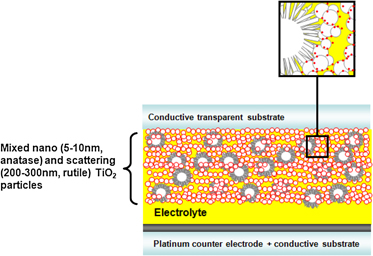Crossref Citations
This article has been cited by the following publications. This list is generated based on data provided by
Crossref.
Liang, Liangliang
Liu, Yumin
and
Zhao, Xing-Zhong
2013.
Double-shell β-NaYF4:Yb3+, Er3+/SiO2/TiO2 submicroplates as a scattering and upconverting layer for efficient dye-sensitized solar cells.
Chemical Communications,
Vol. 49,
Issue. 38,
p.
3958.
Zhao, Peng
Zhu, Yihua
Yang, Xiaoling
Jiang, Xin
Shen, Jianhua
and
Li, Chunzhong
2014.
Plasmon-enhanced efficient dye-sensitized solar cells using core–shell-structured β-NaYF4:Yb,Er@SiO2@Au nanocomposites.
J. Mater. Chem. A,
Vol. 2,
Issue. 39,
p.
16523.
Benehkohal, Nima Parsi
and
Demopoulos, George P.
2014.
Green‐Engineered All‐Substrate Mesoporous TiO2 Photoanodes with Superior Light‐Harvesting Structure and Performance.
ChemSusChem,
Vol. 7,
Issue. 3,
p.
813.
Thapa, Amit
Zai, Jiantao
Elbohy, Hytham
Poudel, Prashant
Adhikari, Nirmal
Qian, Xuefeng
and
Qiao, Qiquan
2014.
TiO2 coated urchin-like SnO2 microspheres for efficient dye-sensitized solar cells.
Nano Research,
Vol. 7,
Issue. 8,
p.
1154.
Demopoulos, G. P.
2015.
From extractive metallurgy to materials engineering: personal teaching and research perspective.
Canadian Metallurgical Quarterly,
Vol. 54,
Issue. 2,
p.
129.
Cherrington, Ruth
Hughes, Darren J.
Senthilarasu, S.
and
Goodship, Vannessa
2015.
Inkjet‐Printed TiO2 Nanoparticles from Aqueous Solutions for Dye‐Sensitized Solar Cells (DSSCs).
Energy Technology,
Vol. 3,
Issue. 8,
p.
866.
Wang, Min
Zai, Jiantao
Wei, Xiao
Chen, Wenlong
Liang, Na
Xu, Miao
Qi, Rongrong
and
Qian, Xuefeng
2015.
N-type hedgehog-like CuBi2O4 hierarchical microspheres: room temperature synthesis and their photoelectrochemical properties.
CrystEngComm,
Vol. 17,
Issue. 21,
p.
4019.
Yasin, Amrita
Guo, Fuqiang
and
Demopoulos, George P.
2016.
Continuous-reactor, pH-controlled synthesis of multifunctional mesoporous nanocrystalline anatase aggregates.
Chemical Engineering Journal,
Vol. 287,
Issue. ,
p.
398.
Yasin, Amrita
Guo, Fuqiang
and
Demopoulos, George P.
2016.
Aqueous, Screen-Printable Paste for Fabrication of Mesoporous Composite Anatase–Rutile TiO2Nanoparticle Thin Films for (Photo)electrochemical Devices.
ACS Sustainable Chemistry & Engineering,
Vol. 4,
Issue. 4,
p.
2173.
Bai, Lihua
Liu, Xiaolian
Li, Meiya
Guo, Kaimo
Luoshan, Mengdai
Zhu, Yongdan
Jiang, Renhui
Liao, Lei
and
Zhao, Xingzhong
2016.
Plasmonic Enhancement of the Performance of Dye-sensitized Solar Cells by Incorporating Hierarchical TiO2 Spheres Decorated with Au Nanoparticles.
Electrochimica Acta,
Vol. 190,
Issue. ,
p.
605.
Yasin, Amrita
Guo, Fuqiang
Sussman, Micah J.
Gauvin, Raynald
and
Demopoulos, George P.
2016.
Steady‐State, Scalable Production of Mesoporous Rutile and Brookite Particles and Their Use in Energy Conversion and Storage Cells.
ChemNanoMat,
Vol. 2,
Issue. 10,
p.
980.
Padrón-Hernández, W.Y.
Ceballos-Chuc, M.C.
Pourjafari, D.
Oskam, G.
Tinoco, J.C.
Martínez-López, A.G.
and
Rodríguez-Gattorno, Geonel
2018.
Stable inks for inkjet printing of TiO2 thin films.
Materials Science in Semiconductor Processing,
Vol. 81,
Issue. ,
p.
75.
Karunakaran, Santhosh Kumar
Arumugam, Gowri Manohari
Yang, Wentao
Ge, Sijie
Khan, Saqib Nawaz
Lin, Xianzhong
and
Yang, Guowei
2019.
Recent progress in inkjet-printed solar cells.
Journal of Materials Chemistry A,
Vol. 7,
Issue. 23,
p.
13873.
Chalastara, Konstantina
Guo, Fuqiang
Elouatik, Samir
and
Demopoulos, George P.
2020.
Tunable Composition Aqueous-Synthesized Mixed-Phase TiO2 Nanocrystals for Photo-Assisted Water Decontamination: Comparison of Anatase, Brookite and Rutile Photocatalysts.
Catalysts,
Vol. 10,
Issue. 4,
p.
407.





